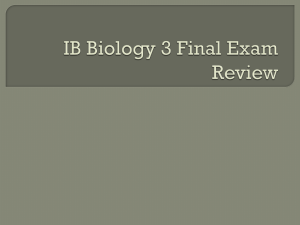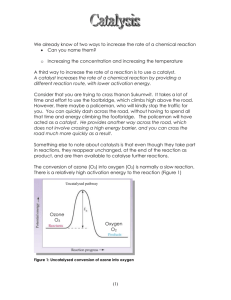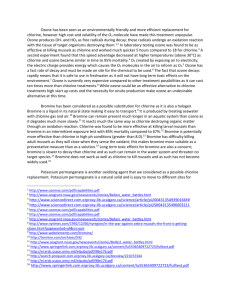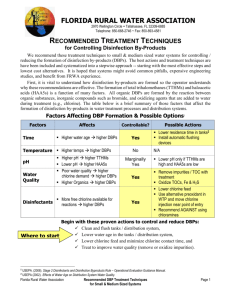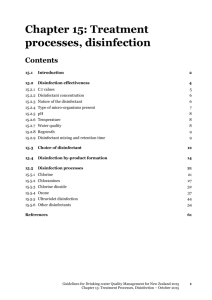Pathogen Reduction and Quality of Lettuce Treated with
advertisement
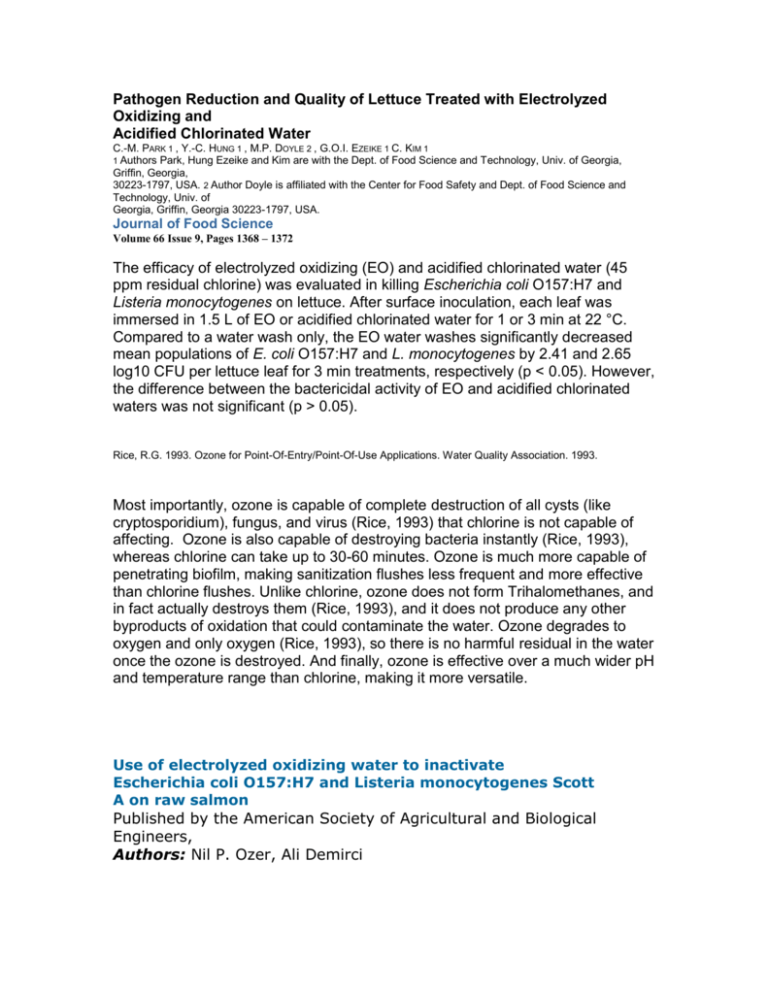
Pathogen Reduction and Quality of Lettuce Treated with Electrolyzed Oxidizing and Acidified Chlorinated Water C.-M. PARK 1 , Y.-C. HUNG 1 , M.P. DOYLE 2 , G.O.I. EZEIKE 1 C. KIM 1 1 Authors Park, Hung Ezeike and Kim are with the Dept. of Food Science and Technology, Univ. of Georgia, Griffin, Georgia, 30223-1797, USA. 2 Author Doyle is affiliated with the Center for Food Safety and Dept. of Food Science and Technology, Univ. of Georgia, Griffin, Georgia 30223-1797, USA. Journal of Food Science Volume 66 Issue 9, Pages 1368 – 1372 The efficacy of electrolyzed oxidizing (EO) and acidified chlorinated water (45 ppm residual chlorine) was evaluated in killing Escherichia coli O157:H7 and Listeria monocytogenes on lettuce. After surface inoculation, each leaf was immersed in 1.5 L of EO or acidified chlorinated water for 1 or 3 min at 22 °C. Compared to a water wash only, the EO water washes significantly decreased mean populations of E. coli O157:H7 and L. monocytogenes by 2.41 and 2.65 log10 CFU per lettuce leaf for 3 min treatments, respectively (p < 0.05). However, the difference between the bactericidal activity of EO and acidified chlorinated waters was not significant (p > 0.05). Rice, R.G. 1993. Ozone for Point-Of-Entry/Point-Of-Use Applications. Water Quality Association. 1993. Most importantly, ozone is capable of complete destruction of all cysts (like cryptosporidium), fungus, and virus (Rice, 1993) that chlorine is not capable of affecting. Ozone is also capable of destroying bacteria instantly (Rice, 1993), whereas chlorine can take up to 30-60 minutes. Ozone is much more capable of penetrating biofilm, making sanitization flushes less frequent and more effective than chlorine flushes. Unlike chlorine, ozone does not form Trihalomethanes, and in fact actually destroys them (Rice, 1993), and it does not produce any other byproducts of oxidation that could contaminate the water. Ozone degrades to oxygen and only oxygen (Rice, 1993), so there is no harmful residual in the water once the ozone is destroyed. And finally, ozone is effective over a much wider pH and temperature range than chlorine, making it more versatile. Use of electrolyzed oxidizing water to inactivate Escherichia coli O157:H7 and Listeria monocytogenes Scott A on raw salmon Published by the American Society of Agricultural and Biological Engineers, Authors: Nil P. Ozer, Ali Demirci This study was undertaken to evaluate the efficacy of electrolyzed oxidizing (EO) water for inactivation of E. coli O157:H7 and L. monocytogenes Scott A on the surfaces (muscle and skin surfaces) of inoculated salmon fillets. Inoculated salmon fillets were treated only with acidic EO water at 22°C and 35°C and sodium hypochlorite solution (90 ppm free chlorine) as control at 22°C for 2, 4, 8, 16, 32, and 64 min, respectively. … The acidic EO water treatments resulted in reductions of population of L. monocytogenes Scott A ranging from 0.40 log10 CFU/g (60 %) at 22°C to 1.12 log10 CFU/g (92.3 %) at 35°C. Treatment of inoculated salmon fillets in acidic EO water reduced E. coli O157:H7 populations by 0.49 log10 CFU/g (67 %) 22°C and 1.07 log10 CFU/g (91.1 %) at 35°C, respectively. Comparing the Efficacy of Chlorine, Chlorine Dioxide, and Ozone in the Inactivation of Cryptosporidium parvum in Water from Parana State, Southern Brazil TRACZ PEREIRA Juliana (1) ; OLIVEIRA COSTA Adriana (1) ; DE OLIVEIRA SILVA Marcia Benedita (2) ; SCHUCHARD Wagner (3) ; OSAKI Silvia Cristina (4) ; DE CASTRO Edilene Alcantara (1) ; PAULINO Rosangela Clara (1) ; THOMAZ SOCCOL Vanete (1) ; In the present work, assays were performed to compare the efficacy of hypochlorous acid, chlorine dioxide, and ozone in the inactivation of Cryptosporidium oocyst in public water supply from Brazilian South conditions. Experiments were carried out in samples containing 2 x 104 oocysts/ml of C. parvum purified from feces of experimentally contaminated calves. An in vitro excystation method was used to evaluate oocysts' viability and to determine the inactivation rates of hypochlorous acid at 2 ppm, chlorine dioxide at 1, 2, and 5 ppm, and ozone at the doses of 0.18, 0.24, 0.36, 0.48, and 1.44 mg/l. By using hypochlorous acid, the maximum inactivation rate obtained was 49.04% after 120 min. Chlorine dioxide at 5 ppm inactivated 90.56% of oocysts after 90 min of contact. Ozone was the most effective product, rendering an inactivation of 100% with the concentration of 24 mg/l. Resistance of Cryptosporidium to the usual disinfectants and the need for more effective water treatments to prevent waterbome diseases in Brazil are discussed in this manuscript.

